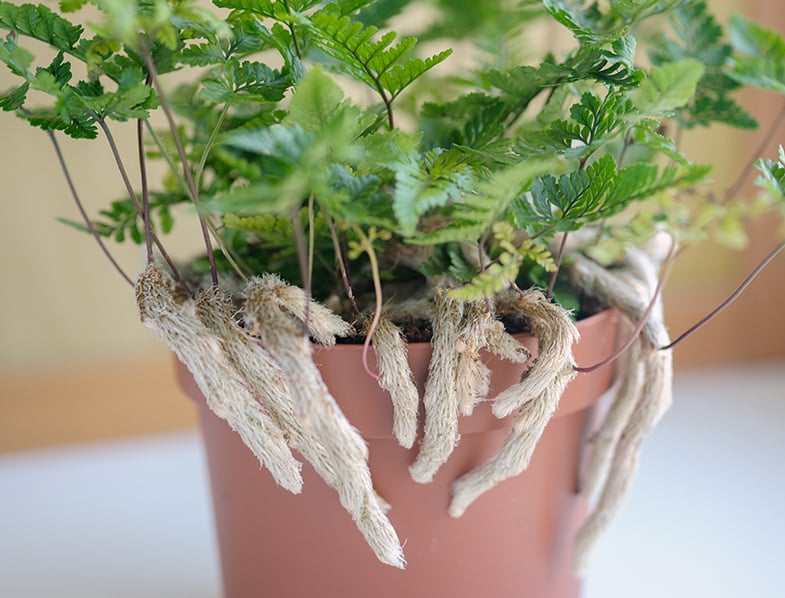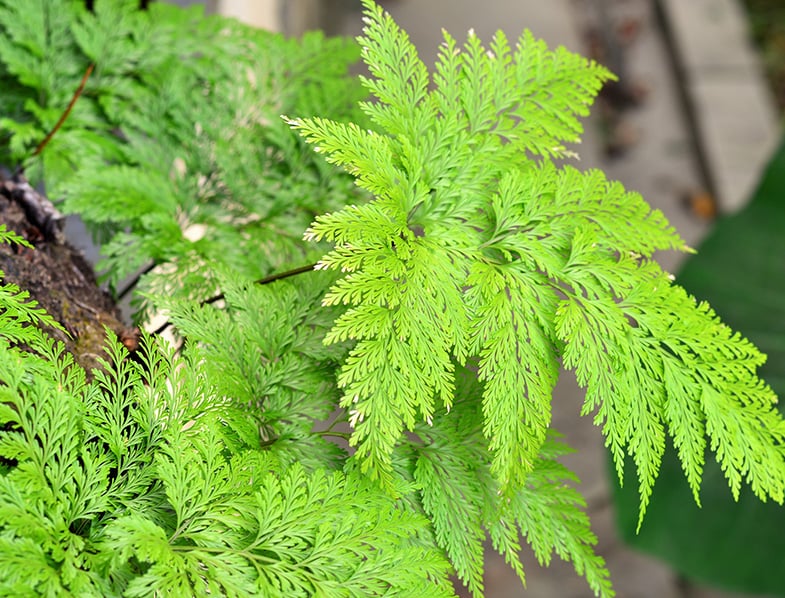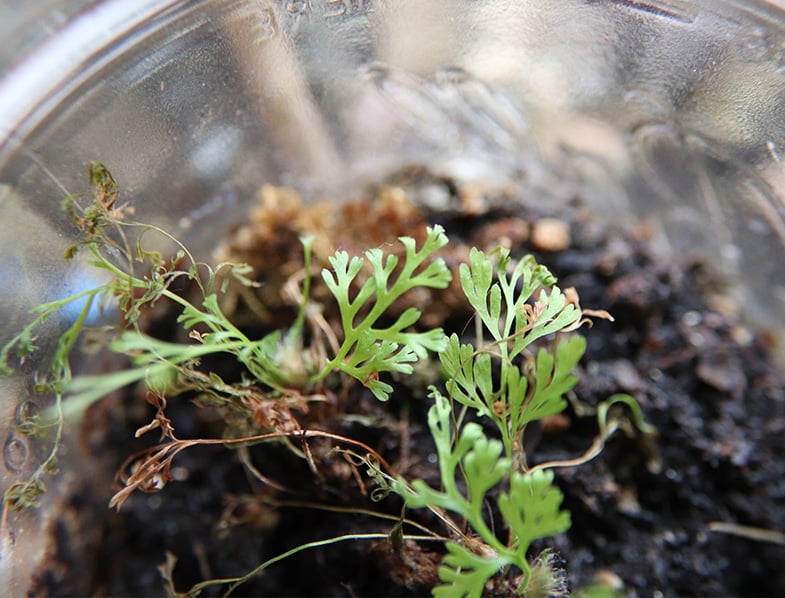The Davallia fejeensis is a tropical plant that offers a touch of nature suitable for any indoor space. Most ferns need a lot of humidity to thrive, but the Davallia fejeensis species can survive on much less.
These green beauties need plenty of indirect light, but only average temperatures to be happy and healthy. The rabbit foot fern is prized by armature gardeners and homeowners alike for their beautiful lacy fronds. As an evergreen, the Davallia fejeensis will stay green all year long with proper care and cultivation.
Another point of pride of the Davallia fejeensis is the furry light-brown colored rhizomes that tend to hang over the sides of the container. The hair on the surface of the creeping rhizomes makes them look like a rabbit’s foot, which is where this houseplant got its name.
While you can plant the rabbit foot fern in a pot, they look much better when placed in a hanging basket. These attractive plants love moisture so daily misting is a must. Watering with room temperature water will also help the soil stay moist which the plant needs to thrive.
Watch Our Latest YouTube Video ...
| Fact | Description |
|---|---|
| Botanical Name | Davallia fejeensis |
| Common Name | Rabbit Foot Fern |
| Native Region | Fiji |
| Growth Requirements | Moderate to bright light, average temperatures (60-75 degrees), indirect sunlight |
| Rhizome Appearance | Furry, light-brown, resembles a rabbit’s foot |
| Maturity Size | Typically around 18 inches, can grow as long as two feet |
| Watering Needs | Soil should always be moist but not soggy |
| Humidity Requirement | 40% to 50% |
| Soil Preference | Well-draining potting mix |
| Repotting | Typically every other year, best in spring |
| Propagation | Divide rhizomes during spring or summer |
| Special Care Tips | Avoid direct sunlight, ensure ample humidity, protect from temperatures below 55 degrees |
About the Rabbit Foot Fern
- The botanical name of the Rabbit Foot Fern is Davallia fejeensis.
- The Davallia fejeensis loves average temperatures.
- The creeping rhizomes of this plant are covered in a brown fuzz that looks like hair.
- Davallia fejeensis have long fronds that look a bit like lace
- The rabbit foot fern should maintain moist soil at all times.
- The root system of the rabbit foot fern is shallow like most rhizomes.
- The rabbit foot fern plant originates from Fiji.

Rabbit Foot Fern Features: An Overview
- Rabbit foot ferns do not need as much humidity as traditional fern plants.
- Mature Davallia fejeensis plants can grow as long as two feet.
- Rabbit foot fern plants are evergreen and keep their color in every season.
- The Davallia fejeensis usually is about 18 inches when mature.
- The light-brown hair on this plant gives it the look of a rabbit’s foot.
- The rabbit foot fern is a Pacific island native.
Growing The Rabbit Foot Fern
Growing the rabbit foot fern is easy. It has a medium growth rate and is not picky about its environment or soil. It only needs to be repotted once it outgrows its current container, which usually will be every other year.
Make sure to repot the plant in the spring for less shock to the roots. Speaking of roots, the rabbit foot fern has a shallow root system and will need to be housed in a pot to match. A shallow but wide pot is ideal for rabbit foot fern plants.
In the winter the rabbit foot fern will shed leaflets, but they will grow again in the spring. Increasing humidity around the plant will prevent excessive leaf loss in the winter. The furry rhizomes that tend to sit on the surface of the soil should never be buried.
- White Rabbit's Foot Fern 4" pot - Davallia
- 840344208706
- Good terrarium plant
- Hirt's Gardens
- Garden & Patio
- 𝐋𝐈𝐕𝐄 𝐈𝐍𝐃𝐎𝐎𝐑 𝐏𝐋𝐀𝐍𝐓 Invite luck and beauty into your space with the Rabbit Foot Fern, a resilient and enchanting plant adorned with furry rhizomes that resemble the lucky foot of a rabbit. If your plant-raising journey has faced challenges, let this unique fern be the one to turn the tide and bring a touch of the exotic to your indoor sanctuary
- 𝐒𝐔𝐍𝐋𝐈𝐆𝐇𝐓 𝐑𝐄𝐐𝐔𝐈𝐑𝐄𝐌𝐄𝐍𝐓𝐒 Adaptable to low to bright indirect light, this plant gracefully thrives in various light conditions, bringing a touch of the exotic to your indoor space.
- 𝐖𝐀𝐓𝐄𝐑𝐈𝐍𝐆 𝐆𝐔𝐈𝐃𝐄 Water once every week, allowing the soil to dry approximately 2 inches down for optimal care and health
- 𝐏𝐄𝐓 𝐂𝐀𝐑𝐄 Perfect for households with furry friends, this plant is very pet-friendly, ensuring a harmonious and worry-free environment
- 𝐏𝐋𝐀𝐍𝐓 𝐂𝐀𝐑𝐄 Perfect for beginners, these low-maintenance plants offer an ideal starting point for aspiring plant enthusiasts. Embrace the joy of nurturing greenery with ease
Last update on 2024-09-18 / Affiliate links / Images from Amazon Product Advertising API
The shallow root system is sensitive to depth and if you bury the rhizomes, they will rot. Repotting season is also the best time to split the plant if you are interested in propagating the rabbit foot fern.
Winter is a dormant time for the rabbit foot fern. While the soil should always stay moist, it will need less water in the winter months. The rabbit foot fern should never be in temperatures that drop below 55 degrees as it can trigger plant failure.
Also, keep your rabbit foot fern plant out of the direct path of air conditioner vents and heaters. While propagation is easy, you can also find young rabbit foot fern plants in most nurseries and garden centers during the spring or summer months.
Watering The Rabbit Foot Fern
Watering the rabbit foot ferns is pretty simple. Regular watering schedules should be observed during the growing season. This is generally the spring through the fall season. The soil of the rabbit foot fern plant should always stay moist, but never allow it to get soggy.
Between each watering allow the top one inch of soil to dry out. The roots of this plant are shallow, so it is important to pay attention to how much water is placed in the soil to prevent root rot.
Unlike other ferns, the Davallia fejeensis only needs a moderate amount of humidity. Anything ranging between 40% and 50% will suffice. Overly dry or overly hot air will make the tips of the plant turn brown, but this can be easily remedied.
All you have to do is cut off the brown areas with a sharp pruning knife and then increase the level of humidity around the plant. Consider using a pebble humidity tray or placing a cool-mist room humidifier in the room. Misting is also a great way to ensure this plant gets the moisture it needs to thrive.
Light watering on a daily or every other day basis is the best way to ensure the plant stays properly moistened. Misting on a regular basis also helps to keep the plant free of pests and helps prevent the surface of the rhizomes from getting dehydrated. Mix in a bit of liquid fertilizer during your bi-weekly watering session, but only during the growing season.
The idea mix to prevent soggy roots is potting soil 1 part and horticultural sand 1 part. Avoiding using chemicals such as leaf shine products or insecticide. These types of products will harm the plant and can even lead to plant failure.

Propagating The Rabbit Foot Fern
The propagation of the rabbit foot fern is rather simple. You can choose the summer or spring to create new plants. Take a mature rabbit foot fern and divide the rhizomes. This is pretty easy since they tend to produce plenty of them as they develop.
When dividing, take special care to keep the stems and roots attached to the new plant. Place your separated rhizome into a fresh pot of sterile soil The soil can be a regular houseplant potting mix or any good quality organic potting mix.
The rabbit fit fern plant roots are not able to hold much water, so be careful when watering new plants. Don’t plant the roots too deeply. These rhizomes thrive when planted in fresh, moist, but shallow soil.
It will take a couple of weeks for the new plants to firmly root in their new containers, but once they do, they will have a stunning appearance.
Rabbit foot ferns are decorative plants that are also functional. The roots of this furry looking rhizome soak up both moisture and nutrients as they spread over the soil. You can place this creative looking plant in a shallow pot on your table, or you can house it in a hanging planter.
When placed in a hanging planter the fuzzy rhizomes are allowed to be on full display. If you have both the time and energy, you can even train this plant to crawl up a gardening trellis for a unique look.

Conclusion
For those looking for a new plant to add to their home, the rabbit foot fern makes a lovely choice. This tropical plant loves moderate to bright light and thrives under fluorescent grow lights.
Caring for this houseplant is rather easy and takes little to no effort. Kids, busy homeowners, and hobby gardeners will love the ease of caring for this plant. Along with being easy to care for, the rabbit foot fern is aesthetically pleasing.
Rabbit foot ferns are not fussy about their soil. Any quality potting mix that is well-draining will suffice for this temperate fern. It loves average room temperatures, generally those ranging between 60 degrees and 75 degrees.
In the winter, the plant can tolerate temperatures as low as 55 degrees so long as humidity levels are maintained. Feed your rabbit foot fern a diluted balanced liquid fertilizer during the growing seasons. Only feed it once per month, and avoid fertilizing it during the dormant winter months.
As a rhizome, the rabbit foot fern can grow quite long over time. With proper care, the long furry roots will start to look like spider legs. This can be a bit off-putting for some but may be a conversation starter for others. Take care to avoid burying the roots under the soil as it will trigger root rot. Maintain a stable level of moisture and provide regular fertilization for your plant to thrive.
It is normal for older fronds to fall off in the winter, but if newer fronds start to shed, make sure your plant is getting ample sunlight. East facing rooms provide the most light without exposing the plant to direct sun, which may result in scorching.
Indoor pollution such as scented candles and smoke will cause the plant to wilt while repeated exposure can result in plant death.
Rabbit Foot Fern FAQ
How do you take care of a rabbit foot fern?
To care for a rabbit foot fern, ensure it has moderate to bright light, keep its soil consistently moist but not soggy, and maintain humidity levels around 40% to 50%. They prefer average room temperatures between 60-75 degrees.
Do rabbit foot ferns like sun or shade?
Rabbit foot ferns prefer indirect sunlight. Direct sunlight may scorch the plant. An east-facing room that provides ample light without direct sun exposure is ideal.
Are rabbit foot ferns hard to care for?
No, rabbit foot ferns are relatively easy to care for. They adapt well to indoor conditions and aren’t overly demanding in terms of humidity or soil type.
Is a rabbit foot fern indoor or outdoor?
While native to tropical regions outdoors, the rabbit foot fern is popularly cultivated as an indoor plant, especially in non-tropical climates.
How do you take care of a rabbit foot fern in the winter?
During winter, the rabbit foot fern enters a dormant phase. It needs less water, but the soil should remain moist. Ensure that the temperature doesn’t drop below 55 degrees and maintain humidity levels. Older fronds may fall off, but new ones will emerge in the spring.
Can you overwater a rabbit foot fern?
Yes, you can overwater a rabbit foot fern. The plant’s roots are shallow, so excessive water can lead to root rot. The soil should be moist, but it’s essential to avoid making it soggy. Allow the top inch of soil to dry out between watering sessions.




1 Comment
Good evening,
I bought two of these ferns from a nursery today, they are in such bad condition, one’s leaves are half dead and the other one has no leaves, only the roots I think that is called the rabbit’s foot.
Please can you give me any advice as to how to get these plants to grow, my heart is breaking to see them in such a bad state, it was my mother’s favorite plant and I feel I have to get them to grow, please help.
Many thanks
Jennifer